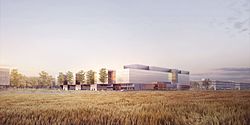Organization:Centre for Nanosciences and Nanotechnologies
 | |
| Focus | Nanoscience |
|---|---|
| Head | Giancarlo Faini (director),[1] |
| Owner | University of Paris-Saclay, CNRS |
| Location | Palaiseau , France |
| Website | www |
The Centre for Nanosciences and Nanotechnologies (French: Centre de Nanosciences et de Nanotechnologies de l'université Paris-Saclay) or C2N, is a nanotechnology laboratory created as joint research unit (UMR 9001) between the University of Paris-Saclay and the French National Centre for Scientific Research (CNRS).[2]
CNRS and the university announced this collaboration in 2013, with the goal of uniting two existing laboratories of Ile-de-France: the Institute for Fundamental Electronics (Institut d'Electronique Fondamentale, IEF) and the Laboratory for Photonics Nanostructures (Laboratoire de Photonique et de Nanostructures, LPN).[3]
Facility construction began in April, 2015, the first stone was laid on June 28, 2016, and the C2N facility began operations in September, 2017.[4] It is located on the Paris-Saclay campus in Palaiseau, 20 miles south of Paris, France .[2]
According to the European Union's MIR-Bose project, "The Centre for Nanoscience and Nanotechnology (C2N) is one of the largest laboratories of University Paris-Sud with 283 members including 83 permanent researchers, 160 PhD students and post-doctoral researchers and 40 technical and administrative staff members."[5]
Research areas
The core of the research is based silicon and III-V nano-electronics, nanomagnetism (spintronics), micro- and nano-photonics (III-V and silicon photonics), and nanosystems (manufacturing and characterization.) It has four main divisions:
- Photonics department,
- Materials Department,
- Nanoelectronics Department,
- Microsystems and Nanobiofluidics Department.[6][1]
The C2N is one of three major French centers of research on nanotechnology (the other two are in Grenoble and Toulouse.)[3] Several other related research groups are located near Paris-Saclay, including Thales, and STMicroelectronics. Scientists from other institutions visit C2N to make use of its single-photon source.[7]
C2N researchers fabricated a chip used as the miniature "particle collider" that produced the first solid confirmation of the quasiparticles anyons, a scientific collaboration with ENS researchers that was featured on the cover of Science.[8][9]
References
- ↑ 1.0 1.1 C2N Organization Chart (January, 2021)
- ↑ 2.0 2.1 "Le C2N de Saclay, nouveau temple de la recherche signé Schüco à Palaiseau". Cahiers du Techniques du Bâtiment. April 2, 2020. https://www.cahiers-techniques-batiment.fr/article/le-c2n-de-saclay-nouveau-temple-de-la-recherche-signe-schuco-a-palaiseau.44296. "...Né de la décision conjointe du CNRS et de l’Université Paris-Sud de fusionner et de regrouper sur un même site le Laboratoire de Photonique et de Nanostructures (LPN) et l’Institut d’Electronique Fondamentale (IEF.) (Born from the joint decision of the CNRS and the University of Paris-Sud to merge and bring together on a single site the Laboratory of Photonics and Nanostructures (LPN) and the Institute of Fundamental Electronics (IEF.)"
- ↑ 3.0 3.1 "Un centre de nanosciences et de nanotechnologies à Paris-Saclay". L’Etablissement public d’aménagement Paris-Saclay. June 18, 2013. https://www.epaps.fr/wp-content/uploads/2013/07/2013-06-13_CP-C2N-VD11.pdf. "Le CNRS et l’université Paris-Sud ont choisi l’opération d’intérêt national Paris-Saclay pour installer le Centre de Nanosciences et de Nanotechnologies (C2N)...s’installera en 2017 à Paris-Saclay dans le quartier de l’Ecole polytechnique. (CNRS and Paris-Sud University have chosen the Paris-Saclay operation of national interest to install the Center for Nanosciences and Nanotechnologies (C2N)... will set up in Paris-Saclay in 2017 in the district of the Ecole Polytechnique."
- ↑ "Centre de nanosciences et nanotechnologies". L’Etablissement public d’aménagement Paris-Saclay. https://www.epaps.fr/projets/tous-les-projets/centre-de-nanoscience-et-nanotechnologie/. "L’arrivée de C2N permettra de constituer le regroupement académique le plus important d’Europe en photonique et en électronique de spin. (The arrival of C2N will make it possible to constitute the largest academic grouping in Europe in photonics and spin electronics.)"
- ↑ "Université Paris-Sud - Centre for Nanoscience and Nanotechnology (C2N)". MIR-Bose Project. https://mir-bose.eu/index.php/partners/universite-paris-sud/. "The Centre for Nanoscience and Nanotechnology (C2N) is one of the largest laboratories of University Paris- Sud with 283 members including 83 permanent researchers, 160 PhD students and post-doctoral researchers and 40 technical and administrative staff members...Its activities focus on nanoscience: nanophotonics, nanoelectronics and micro-nano systems."
- ↑ Presentation, C2N
- ↑ Larousserie, David (November 21, 2017). "Dans l'Essonne, une source quasi unique au monde de grains de lumière permet d'alimenter les calculateurs quantiques". Le Monde. https://www.lemonde.fr/sciences/article/2017/11/21/une-fontaine-de-photons-miraculeuse_5217916_1650684.html.
- ↑ "Fractional statistics of anyons in a two-dimensional conductor" (C2N News, April 10, 2020)
- ↑ Ornes, Stephen (December 12, 2020). "Physicists Prove Anyons Exist, a Third Type of Particle in the Universe". Discover Magazine. https://www.discovermagazine.com/the-sciences/physicists-prove-anyons-exist-a-third-type-of-particle-in-the-universe. "This year brought two solid confirmations of the quasiparticles. The first arrived in April, in a paper featured on the cover of Science...physicists sent an electron gas through a teeny-tiny particle collider to tease out weird behaviors — especially fractional electric charges — that only arise if anyons are around."
External links
- {{LinkedIn page}} template missing URL and not present in Wikidata.
- {{Twitter}} template missing ID and not present in Wikidata.
[ ⚑ ] 48°42′44″N 2°11′47″E / 48.7122°N 2.1963°E
 |

